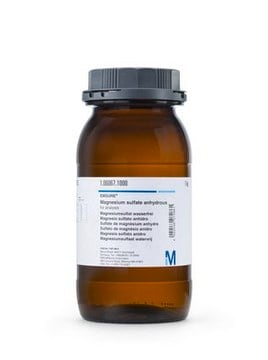793612
Magnesium sulfate
anhydrous, free-flowing, Redi-Dri™, reagent grade, ≥97%
Sign Into View Organizational & Contract Pricing
All Photos(8)
About This Item
Empirical Formula (Hill Notation):
MgSO4
CAS Number:
Molecular Weight:
120.37
EC Number:
MDL number:
UNSPSC Code:
12352302
PubChem Substance ID:
NACRES:
NA.21
assay:
≥97%
grade:
anhydrous
reagent grade
reagent grade
form:
powder or granules
Recommended Products
grade
anhydrous
reagent grade
Quality Level
vapor density
<0.01 (vs air)
vapor pressure
<0.1 mmHg ( 20 °C)
product line
Redi-Dri™
assay
≥97%
form
powder or granules
quality
free-flowing
SMILES string
[Mg++].[O-]S([O-])(=O)=O
InChI
1S/Mg.H2O4S/c;1-5(2,3)4/h;(H2,1,2,3,4)/q+2;/p-2
InChI key
CSNNHWWHGAXBCP-UHFFFAOYSA-L
Looking for similar products? Visit Product Comparison Guide
General description
Magnesium sulfate is an inorganic salt that is used as a magnesium precursor to synthesize Mg-based compounds. It is also used as a catalyst for various organic transformations.
Application
Magnesium sulfate can be used as a precursor salt to synthesize magnesium manganese spinel (MgMn2O4) as cathode material for use in rechargeable Mg batteries. It is also used in aqueous two-phase partitioning systems along with polyethylene glycol for the purification of biomolecules.
MgSO4 (anhydrous) can also be used as a drying agent in organic synthesis for the removal of traces of water from organic extracts.
MgSO4 (anhydrous) can also be used as a drying agent in organic synthesis for the removal of traces of water from organic extracts.
Features and Benefits
- Increased efficiency – Eliminates time and effort of loosening hardened powders
- Safety – Eliminates tools of force used to break up clumps,·
- Ecology – Reduces waste as it does not stick to the packaging
- Economy – Faster preparation and solvation increase productivity and reduce costs
- Assured Quality – Excellent, expert-tested quality with no anti-caking agents
- Flexible volumes – Available from research amounts to scale-up quantities
Legal Information
Redi-Dri is a trademark of Sigma-Aldrich Co. LLC
Storage Class
13 - Non Combustible Solids
wgk_germany
WGK 1
flash_point_f
Not applicable
flash_point_c
Not applicable
Choose from one of the most recent versions:
Already Own This Product?
Find documentation for the products that you have recently purchased in the Document Library.
Customers Also Viewed
Federica Belluti et al.
ChemMedChem, 9(2), 371-382 (2014-01-10)
A significant improvement in the treatment of trypanosomiases has been achieved with the recent development of nifurtimox-eflornithine combination therapy (NECT). As an alternative to drug combinations and as a means to overcome most of the antitrypanosomatid drug discovery challenges, a
Claire L O'Brien et al.
Gut, 63(10), 1596-1606 (2014-01-17)
Our aim was to determine whether or not specific microorganisms were transported selectively to lymph nodes in Crohn's disease (CD) by comparing node and mucosal microbial communities in patients and controls. We also sought evidence of dysbiosis and bacterial translocation.
Robert J Floor et al.
Chembiochem : a European journal of chemical biology, 15(11), 1660-1672 (2014-07-01)
We explored the use of a computational design framework for the stabilization of the haloalkane dehalogenase LinB. Energy calculations, disulfide bond design, molecular dynamics simulations, and rational inspection of mutant structures predicted many stabilizing mutations. Screening of these in small
Audrey Beaussart et al.
ACS nano, 8(10), 10723-10733 (2014-10-07)
A variety of bacterial pathogens use nanoscale protein fibers called type IV pili to mediate cell adhesion, a primary step leading to infection. Currently, how these nanofibers respond to mechanical stimuli and how this response is used to control adhesion
Roberto J Diaz et al.
American journal of physiology. Cell physiology, 306(12), C1191-C1199 (2014-04-25)
We have previously shown that ischemic preconditioning (IPC) protection against necrosis in whole hearts and in both fresh and cultured cardiomyocytes, as well as the improved regulatory volume decrease to hypoosmotic swelling in cardiomyocytes, is abrogated through Cl(-) channel blockade
Our team of scientists has experience in all areas of research including Life Science, Material Science, Chemical Synthesis, Chromatography, Analytical and many others.
Contact Technical Service


